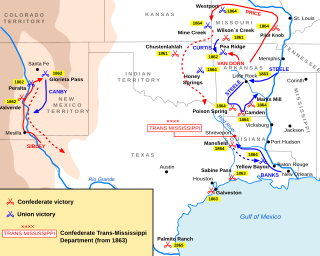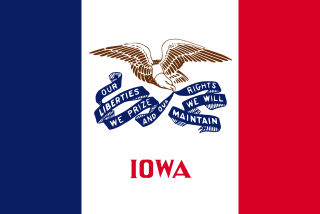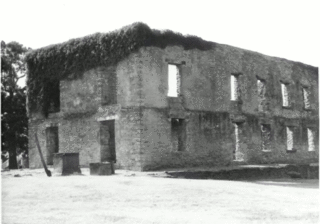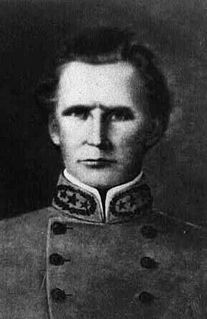| Burton Allen Holder | |
|---|---|
| Born | 1843 Polk County, Missouri |
| Died | 1920 (aged 76–77) Grayson County, Texas |
| Allegiance | |
| Service/ | |
| Years of service | 1864–65 |
| Battles/wars | |
Burton Allen Holder (born between January 16 and March 16, 1843 – 1920) gained fame as a soldier in the Confederate States Army during the American Civil War. During the Red River Campaign, Holder led the 22nd Texas Cavalry Regiment [Dismounted] which kept Union forces out of the Red River and new areas of Texas for the rest of the war.

The Confederate States Army (C.S.A.) was the military land force of the Confederate States of America (Confederacy) during the American Civil War (1861–1865), fighting against the United States forces. On February 28, 1861, the Provisional Confederate Congress established a provisional volunteer army and gave control over military operations and authority for mustering state forces and volunteers to the newly chosen Confederate president, Jefferson Davis. Davis was a graduate of the U.S. Military Academy, and colonel of a volunteer regiment during the Mexican–American War. He had also been a United States Senator from Mississippi and U.S. Secretary of War under President Franklin Pierce. On March 1, 1861, on behalf of the Confederate government, Davis assumed control of the military situation at Charleston, South Carolina, where South Carolina state militia besieged Fort Sumter in Charleston harbor, held by a small U.S. Army garrison. By March 1861, the Provisional Confederate Congress expanded the provisional forces and established a more permanent Confederate States Army.

The American Civil War was a war fought in the United States from 1861 to 1865, between the North and the South. The Civil War is the most studied and written about episode in U.S. history. Primarily as a result of the long-standing controversy over the enslavement of black people, war broke out in April 1861 when secessionist forces attacked Fort Sumter in South Carolina shortly after Abraham Lincoln had been inaugurated as the President of the United States. The loyalists of the Union in the North proclaimed support for the Constitution. They faced secessionists of the Confederate States in the South, who advocated for states' rights to uphold slavery.

The Red River Campaign or Red River Expedition comprised a series of battles fought along the Red River in Louisiana during the American Civil War from March 10 to May 22, 1864. The campaign was a Union initiative, fought between approximately 30,000 Union troops under the command of Major General Nathaniel P. Banks, and Confederate troops under the command of Lieutenant General Richard Taylor, whose strength varied from 6,000 to 15,000.
Holder's parents Isaac Bledsoe Holder (b. December 20, 1783, died 1862) and Elizabeth Ann Stewart (born about 1793) were raised on the Chickasaw Reservation in Alabama. In the 1820s, they and the rest of the "Bleacher" clan moved to southwestern Missouri where the family lived for the next twenty years. Burton A. Holder was born in Polk County, Missouri, sometime in the first three months of 1843. In the 1850s, the family moved to the Indian Territory and then to Grayson County, Texas, where Holder was living when the Civil War erupted in 1861. [1]

Alabama is a state in the southeastern region of the United States. It is bordered by Tennessee to the north, Georgia to the east, Florida and the Gulf of Mexico to the south, and Mississippi to the west. Alabama is the 30th largest by area and the 24th-most populous of the U.S. states. With a total of 1,500 miles (2,400 km) of inland waterways, Alabama has among the most of any state.
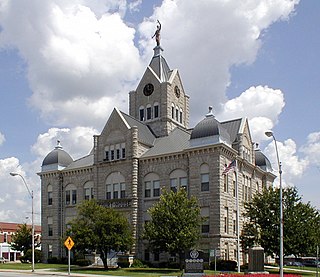
Polk County is a county located in the southwestern portion of the U.S. state of Missouri. As of the 2010 census, the population was 31,137. Its county seat is Bolivar. The county was founded January 5, 1835, and named for Ezekiel Polk.

Grayson County is a county in the U.S. state of Texas. As of the 2010 census, its population was 120,877. The county seat is Sherman. The county was founded in 1846 and is named after Peter Wagener Grayson, an attorney general of the Republic of Texas.
On April 25, 1862, Holder married Nellie Campbell, a 20-year-woman who had been born in North Carolina. They raised several children.

North Carolina is a state in the southeastern region of the United States. It borders South Carolina and Georgia to the south, Tennessee to the west, Virginia to the north, and the Atlantic Ocean to the east. North Carolina is the 28th-most extensive and the 9th-most populous of the U.S. states. The state is divided into 100 counties. The capital is Raleigh, which along with Durham and Chapel Hill is home to the largest research park in the United States. The most populous municipality is Charlotte, which is the second-largest banking center in the United States after New York City.
Holder enlisted in the Confederate Armed forces. By the Red River Campaign in 1864, he was in command of the 22nd Texas Cavalry Regiment [Dismounted].
Holder's wife died at their home in Denison, Texas, in 1890 and Holder died thirty years later. They are buried in Grayson County.

Denison is a city in Grayson County, Texas, United States. It is 75 miles (121 km) north of Dallas. The population was 22,682 at the 2010 census. Denison is part of the Texoma region and is one of two principal cities in the Sherman–Denison Metropolitan Statistical Area. Denison is known as the birthplace of Dwight D. Eisenhower, the 34th President of the United States.

